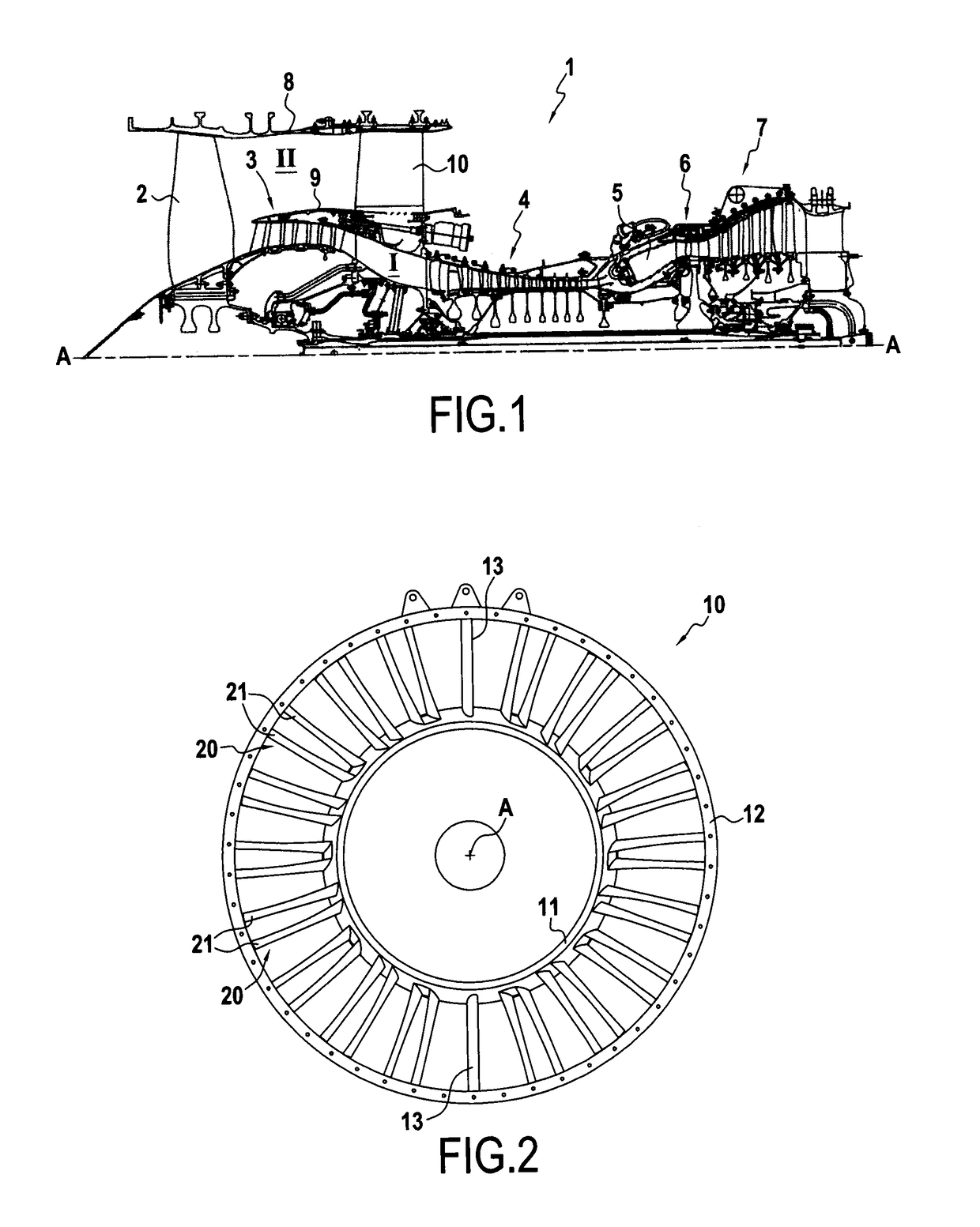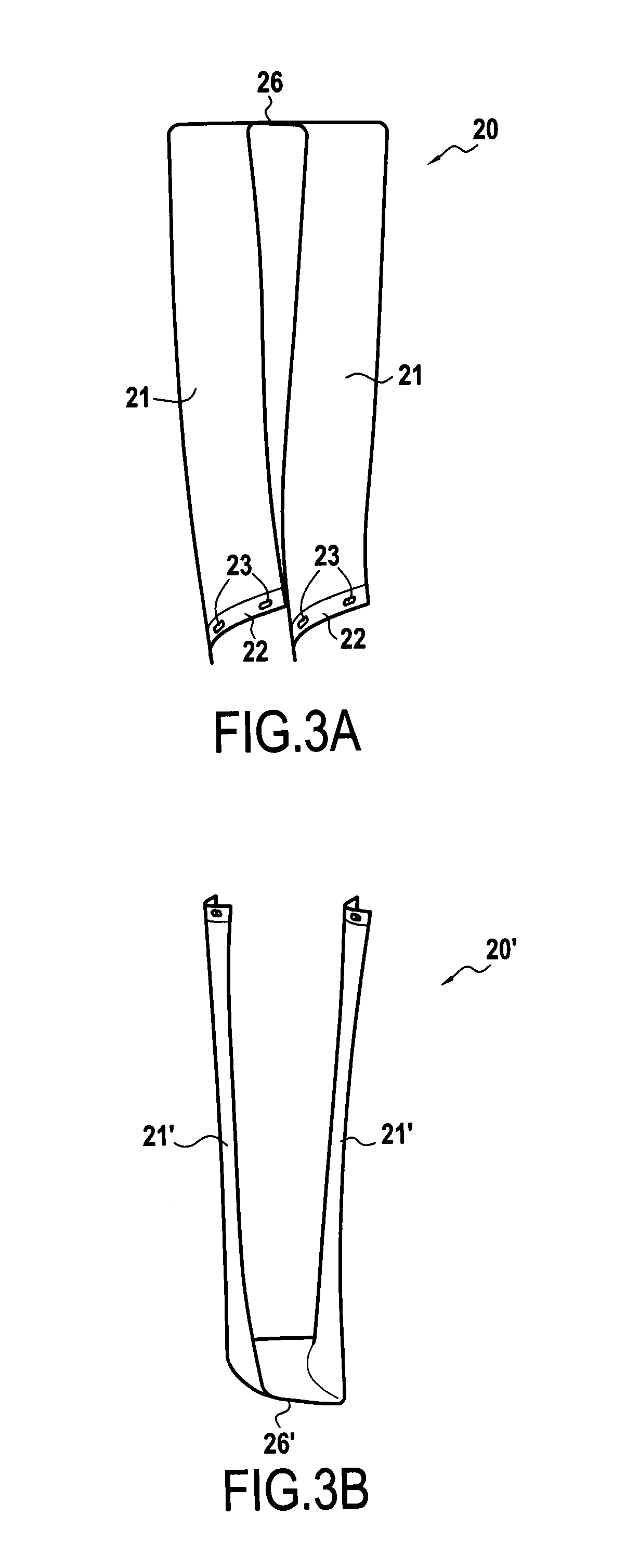Monobloc blade preform and module for a turbo machine intermediate casing
a technology of turbo machines and modules, applied in the direction of machines/engines, efficient propulsion technologies, other domestic articles, etc., can solve the problem of limited overall stiffness of such a module, and achieve the effect of reducing size and weight, increasing stiffness and thickness
- Summary
- Abstract
- Description
- Claims
- Application Information
AI Technical Summary
Benefits of technology
Problems solved by technology
Method used
Image
Examples
second embodiment
[0053]Depending on the type of fastening between the module 20 and the intermediate casing 10 via the transverse vane portion 26, this portion may be an aerodynamic platform constituting a smooth and aerodynamic wall for the secondary passage II of the turbine engine 1, or it may be a flange for fastening the module 20 to the intermediate casing 10. In particular, if the transverse vane portion 26 does not have any fastenings or has fastenings that are suitable for not projecting into the passage II, such as axial or tangential fastenings, the transverse vane portion 26 may act as a platform. In contrast, if the transverse vane portion 26 requires a fastening that projects into the passage II, in particular if it is a radial fastening, then the transverse vane portion 26 acts as a flange and an aerodynamic platform needs to be superposed on the transverse vane portion 26 in order to mask its fastenings. Such examples are described below with reference to the
[0054]In this embodiment,...
embodiment 20
[0057]FIG. 3D shows the woven preform 40 laid out flat, which preform is used for making this first module embodiment 20. FIG. 3E shows how this preform 40 is shaped in order to obtain the module 20. Going from upstream to downstream, i.e. from right to left in the figures, this preform 40 comprises a first longitudinal segment 41, that is to form a first vane 21, a transverse segment 46 that is to form the transverse vane portion 26, and a second longitudinal segment 42 that is to form the second vane 21 of the module 20.
[0058]The preform 40 is taken from a 3D woven sheet of carbon fibers, made using a 3D interlock weave. Only the surfaces of the preform 40 are woven two-dimensionally (2D) with a satin type weave. In order to obtain vanes 21 that are fine and transverse vane portions 26 that are thicker, the transverse segment 46 of the preform 40 has a larger number of layers of yarns than do the longitudinal segments 41 and 42: methods of weaving that make it possible to obtain s...
embodiment 120
[0068]FIG. 4C shows the 3D woven preform 140 laid out flat, which preform is used for making this second module embodiment 120. FIG. 4D shows this preform 140 shaped in order to obtain the module 120. From upstream to downstream, i.e. from right to left in the figures, this preform 140 comprises a first transverse segment 146 that is to form a bottom transverse vane portion 127, a first longitudinal segment 141 that is to form a first vane 121, a second transverse segment 147 that is to form the top transverse vane portion 126, a second longitudinal segment 142 that is to form the second vane 121, and a third transverse segment 148 that is to form the second bottom transverse vane portion 127 of the module 120.
PUM
| Property | Measurement | Unit |
|---|---|---|
| thickness | aaaaa | aaaaa |
| stiffness | aaaaa | aaaaa |
| thrust | aaaaa | aaaaa |
Abstract
Description
Claims
Application Information
 Login to View More
Login to View More - R&D
- Intellectual Property
- Life Sciences
- Materials
- Tech Scout
- Unparalleled Data Quality
- Higher Quality Content
- 60% Fewer Hallucinations
Browse by: Latest US Patents, China's latest patents, Technical Efficacy Thesaurus, Application Domain, Technology Topic, Popular Technical Reports.
© 2025 PatSnap. All rights reserved.Legal|Privacy policy|Modern Slavery Act Transparency Statement|Sitemap|About US| Contact US: help@patsnap.com



